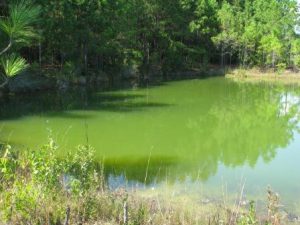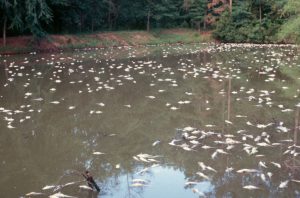When you think of Florida’s top recreational activities, fishing is certainly one of them. The state is full of fishing opportunities from the coast to inland lakes, rivers, and ponds. Despite all these natural fishing avenues, nothing quite beats the convenience of having a little fishing oasis right in your yard. Whether you want a pond as a source of food, supplemental income, or just as an outlet for hours of recreation with your family, proper management is key for pond sustainability.
Water Quality
If you notice that your pond is on the muddy side, the first task is figuring out the route cause. Turbidity is not only visually unappealing but can also disrupt biological production due to limited light penetration. Also keep in mind that muddy (turbid) water is caused by suspended clay and silt particles, which is different than stained or green colored water.

Causes of muddy water:
- Insufficient vegetation along the pond bank. A lack of vegetation along the shoreline can lead to soil erosion.
- Too shallow of shoreline areas. These can be dug deeper.
- High winds. Wind can be reduced by planting trees or other tall vegetation that act as wind breakers around your pond.
- Burrowing by crayfish or other bottom dwelling type species. Largemouth bass and bream can help reduce crayfish populations.
If you have practiced these methods and still find that your pond is muddy, an easy solution is adding hay to the surface of the pond. The hay helps to attract and neutralize soil particles causing them to settle to the bottom. Loosely scatter two square bales per surface acre. The hay will also provide growth of food for small fish.

Ponds that are clear but display a tea coloration are a product of leached tannins and lignin from decaying leaves and vegetation. This coloration is not necessarily harmful to your pond and are still capable of sustaining healthy fish populations. Green water is caused by microscopic algae (phytoplankton). Moderate levels of algae can be present in a healthy pond, however, if water visibility less than 16 inches than this can be evidence of a pond that is over-enriched with nutrients. Prevent excess nutrients in your pond by minimizing fertilizer use within 20 feet of the pond and redirect lawn clippings away from the pond.
Aquatic Vegetation
Aquatic plants are beneficial to fish populations. They produce oxygen, help maintain good water quality, and they provide cover and spawning habitat for fish. However, when left unmanaged, once beneficial vegetation can become a nuisance. When plants are too abundant it can hinder the ability of predator fish species to feed on prey. Also, decaying plants consume large amounts of oxygen and contribute to nutrient overloads. Using proper “aquascaping” desirable species of submerged emergent and shoreline can be utilized to maximize the biological potential of your pond. Managing aquatic vegetation that is out of control requires one or all three methods of weed control.
- Mechanical: removal by hand or machine.
- Chemical: the use of specialized aquatic herbicides. It is best to only treat a third of the total target vegetation at a time to prevent oxygen loss in the pond.
- Biological: fish species or other organisms that consume troublesome vegetation such as grass carp and hyacinth weevil.
Fish Kills, Diseases, and Parasites

Most fish kills are a result of low dissolved oxygen (DO) conditions. DO is the oxygen gas that is dissolved in water and available for fish. Low DO conditions may be caused by algae and aquatic plants using too much oxygen in the absences of sunlight, decaying vegetation, or an excess of runoff containing organic matter. Sudden changes in temperature, DO, salinity, and pH can all stress fish leading to an overall fish kill. These stressors can result in secondary bacterial and viral infections. Good water quality is the best way to prevent fish kills. If low DO levels are a regular issue in your pond, then you should consider installing a type of aeration device. You want to look for a device that will create bottom-to-top vertical mixing (destratification) whiling adding oxygen.
Parasites are common in fish and there isn’t much you can do about them. Parasites dwell throughout the entire fish body including the eyes, digestive tract, and reproductive organs. Most parasites do not cause serious health issues to fish or are the cause of fish kills. These parasites are also not a health threat to humans when the fish is cooked properly.
 0
0
